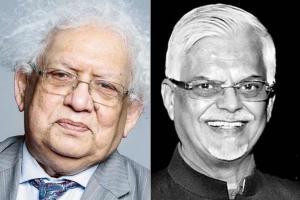Writers of a new collection of essays on why the historic Bombay Plan needs to be read again

Lord Meghnad Desai and Sanjaya Baru
Back in 2004, former PM Dr Manmohan Singh, the key architect of economic liberalisation in the country, admitted that the 'Bombay Plan' had, had a profound impact on him as a student. "It encapsulated what subsequent plans tried to achieve," Singh had said of the economic document.
It wasn't just Singh, who seemed enthralled by it. When the Bombay Plan was published in 1944–45, it generated interest across the world - the American journal Foreign Affairs carried an extensive review by leading economist PS Lokanathan. The attention wasn't misplaced. It was not just the first-of-its-kind plan of economic development for new India, it was also co-authored by a distinguished lot of businessmen - JRD Tata, GD Birla, Purushottamdas Thakurdas, Kasturbhai Lalbhai, Ardeshir Dalal, Lala Shri Ram, John Mathai and AD Shroff, most of whom were from then Bombay, thus, giving it its name.
Yet, Sanjaya Baru and Lord Meghnad Desai, the editors of a new book, The Bombay Plan: Blue print for Economic Resurgence, rue the fact that the document never received its due, quickly fading out of public memory. Their book, a collection of essays, by experts, "who combined scholarship with a feel for the world of policy" is aimed at bringing current policy and academic attention to a document that they feel, "was not only prescient in its approach to development but was also influential in shaping economic planning and public policy in the first decade of India's Independence".
"When I joined FICCI as secretary-general in 2017, I was surprised to discover that not many of FICCI's leaders had even heard of the Bombay Plan. It was after all the most important policy intervention by FICCI's leaders before Independence. So I felt it was time to resurrect the document," said Baru, who was previously media advisor to Dr Singh, of why he decided to pursue the document again.
When Baru approached Desai, who sits as a Labour Peer in the House of Lords, he immediately decided to come on board. "I have read all the various plans, but there was no doubt that the Bombay Plan was the most detailed," Desai says, adding, "Although it was denounced by the Left as Capitalist plot , it was much less ideological than the Gandhian Plan or the People's Plan. It was a professional job, when except for the USSR, national planning had not been discussed anywhere else."
Desai says that while the Five Year Plans may have been more socialist, the Bombay Plan was more people-centred. This is visible in its strong focus on nutrition, education and sanitation. "The planners have laid down minimum living standards on the basis of about 2,800 calories of well-balanced food a day for each person, 30 yards of clothing and 100 square feet of housing; and they also outline the minimum needs for elementary education, sanitation, water supply, village dispensaries and hospitals," Lokanathan had written.
"In that sense the Bombay Plan was more 'socialistic' than the Nehru-Mahalanobis Plans. Even now there isn't adequate recognition in India of the importance of investing in human capital compared to East Asian nations," says Baru.
Desai hopes that the current crop of businessmen learn from their predecessors. "They may be richer, but they are much less powerful than the Bombay Plan [authors], who were not crony capitalists," he says.
Catch up on all the latest Mumbai news, crime news, current affairs, and also a complete guide on Mumbai from food to things to do and events across the city here. Also download the new mid-day Android and iOS apps to get latest updates
 Subscribe today by clicking the link and stay updated with the latest news!" Click here!
Subscribe today by clicking the link and stay updated with the latest news!" Click here!









